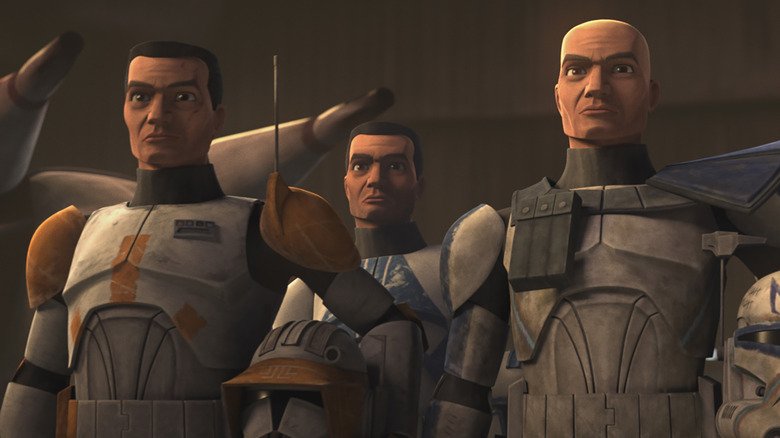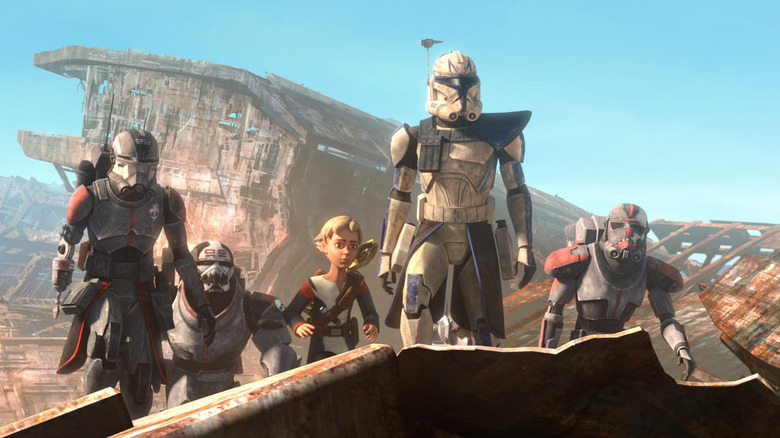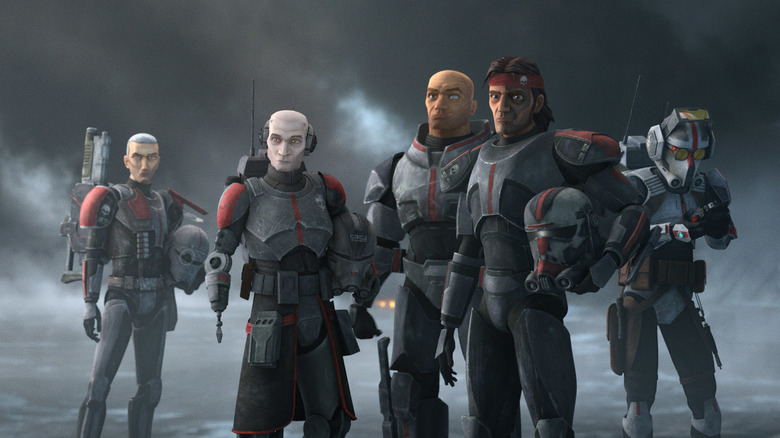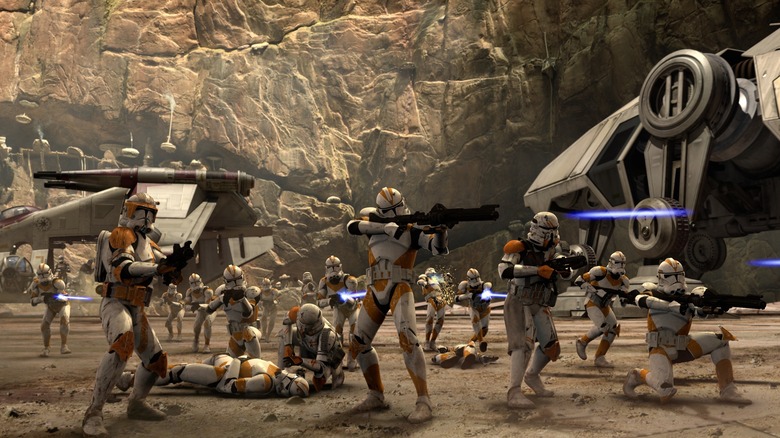Star Wars: What Happened To The Clone Troopers After The Prequel Trilogy?
The Clone Wars have arguably become the most fascinating part of the entire "Star Wars" story. What started as just a stray line uttered by Obi-Wan Kenobi in 1977 has become one of the defining points in the saga's timeline — a galactic conflict explored through films, television, novels, and comics, all detailing how a crumbling republic succumbs to the alluring lies of fascism. The clones themselves signify this societal fall: Despite their nonviolent doctrine, the Jedi willingly take part in the breeding and purchase of slave soldiers, clones built to genetic specifications that make them ideal on the battlefield and as subordinates to their commanders.
It should come as no surprise that after the clones serve their purpose, propping up the newly minted Galactic Empire and wiping out the Jedi under orders from Sheev Palpatine, they are quickly discarded. The soldiers of empire are rarely afforded much care after returning home in the real world, and "Star Wars" mirrors that callousness with which militaristic governments often toss their veterans to the wind.
The transition from clone troopers to recruited stormtroopers certainly didn't happen overnight, but it still happened much faster than you might suspect — at least, in the current canon. The old "Star Wars" Expanded Universe, however, contains a very different account of what happened to the clones after the prequel trilogy.
In canon, clone troopers were quickly phased out
The animated series "Star Wars: The Bad Batch" delves deep into what happened to the clones after Order 66, as it follows a group of specialized troopers unaffected by that command in the wake of the Clone Wars. In order to restrict access to cloning technology, the Empire destroys Kamino's Tipoca City and the cloning facilities therein. This destructive act also pushes the Senate to authorize a widespread military recruitment bill. Forming an army from citizen recruits serves a dual purpose: It's cheaper than cloning perfect soldiers, and it ensures an extra level of loyalty from occupied worlds. You're much less likely to rebel against the Empire when your neighbor's kid is in the army.
The first wave of non-clone Imperial troopers, known as TK stormtroopers, are recruited very soon after the Empire is established. These soldiers are trained by clone veterans under an initiative called Project War-Mantle and wear armor similar to both the final generation of clone armor and the eventual armor seen in the original trilogy.
Though some galactic representatives like Senator Riyo Chuchi of Pantora push for additional legislation to take care of clone veterans, former troopers still suffer greatly. The accelerated aging of the clones' genetic programming means advanced health issues for some, and the Order 66 trigger leaves significant psychological trauma on the clones forced to carry it out. In "Obi-Wan Kenobi," an unhoused clone is seen begging on the streets of Daiyu.
Clone replacement and their role in the Empire
In the early years of the Empire, clones still play a key role in military operations. In "The Bad Batch" Season 2, for instance, a squad including Commander Cody and former Clone Force 99 member Crosshair is deployed to the Separatist holdout world of Desix. In "Andor" Season 1, Cassian Andor has a flashback to the days after the war, in which a company of clones visit the distant planet Ferrix to enforce loyalty to the new regime.
In just a matter of years, though, most of the military has been entirely replaced by recruited soldiers from across the galaxy. Imperial academies — like the one Luke Skywalker mentions in the original "Star Wars" — are set up all over the Empire, promising adventure and stable work for those struggling in the wake of the Clone Wars. This kind of propaganda is seen in other projects like "Star Wars Rebels," where an academy is built on Lothal, and at the beginning of "Solo: A Star Wars Story."
A number of clones, like the Bad Batch themselves — who defect and become mercenaries — manage to avoid Imperial service. Some even join the Rebel Alliance. Captain Rex removes his inhibitor chip after Order 66 is triggered with the help of his longtime friend and comrade Ahsoka Tano. Rex works with the early rebellion to help clones defect. Later, in "Star Wars Rebels," he and fellow clone veterans Wulff and Gregor join Phoenix Squadron. Rex fights the Empire through the end of the Galactic Civil War.
What happened to the clones in Star Wars Legends?
The clones' story goes a little bit differently in the old Expanded Universe. It also doesn't always make sense. That's because when external texts like Karen Traviss' "Republic Commando" novels – some of the best "Star Wars" books — started coming out, the "Clone Wars" animated series hadn't yet addressed how Order 66 worked. In both those books and the story mode for "Star Wars: Battlefront II," it seems that the clones are aware of what's coming well before the actual command is given by Palpatine. This was later retconned in Season 6 of "Star Wars: The Clone Wars," which is part of both the modern canon and the non-canon Legends timeline.
In Legends, clone troopers remain active in the military for much longer than they do in canon. Since there are so many different kinds of stormtroopers, all of whom generally stay masked in the movies, it was hard to say in the EU days who was and wasn't a clone. While cloning activities still wind down in Legends during the Imperial era, the hard cut from clone troopers to stormtroopers isn't as severe. Cloning technology is then allocated to other secret projects, as seen in "Star Wars: The Force Unleashed II." The 501st Legion, known during Imperial rule as Vader's Fist, remains entirely composed of elite clone troopers.



